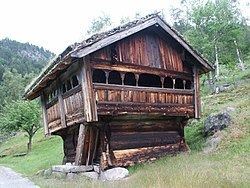Area rank 75 in Norway Area 1,265 km² Local time Saturday 12:12 AM | County Aust-Agder Administrative centre Valle Demonym(s) Valldøl Population 1,289 (2010) | |
 | ||
Weather 0°C, Wind W at 0 km/h, 97% Humidity Points of interest Setesdalsmuseet at Rysstad, Gloppefoss, Holmen, Vetrestoi, Eikestoi, Stoi, Grimestrond | ||
Valle is a municipality in Aust-Agder county, Norway. It is part of the traditional district of Setesdal. The administrative center is the village of Valle.
Contents
- Map of Valle Municipality Norway
- General information
- Name
- Coat of arms
- Politics
- Geography
- History
- Notable residents
- References
Map of Valle Municipality, Norway
General information
Valle was established as a municipality on 1 January 1838 (see formannskapsdistrikt). The area of Bykle (population: 476) was separated from the municipality of Valle on 1 January 1902. This left Valle with 1,720 inhabitants. On 1 July 1915, the area of Hylestad (population: 658) was separated from the municipality of Valle (remaining population: 1,051). On 1 January 1962, Hylestad (population: 662) and Valle (population: 902) were merged back into one municipality named Valle.
Name
The municipality (originally the parish) is named after the old Valle farm (Old Norse: Vǫllr), since the first church was built there. The form of the name is the genitive case, from the common expressions Vallar kirkja (church) and Vallar sókn (parish).
Coat-of-arms
The coat-of-arms is from modern times. They were granted on 11 May 1984. The arms show five Saint Andrew's crosses, forming a larger cross. The composition was based on the decoration in the medieval church in Hylestad in the municipality, and this pattern is used in traditional clothes made in the municipality.
Politics
In the 2007 municipal elections, Valle recorded the highest vote for the Conservative Party in Norway at 48.9 per cent.
Geography
Valle is bordered to the north by Bykle in Aust-Agder and Tokke in Telemark, to the east by Fyresdal in Telemark, to the south by Bygland in Aust-Agder, and to the west by Sirdal in Vest-Agder county.
Valle lies in the middle of Setesdal, a valley and a traditional district in Aust-Agder that included the municipalities of Bykle, Valle, Bygland, Iveland, and Evje og Hornnes. The Otra river flows from the Hardangervidda plateau in Telemark to the north, through the valley of Setesdal (and through Valle), into the sea near the Kristiansand.
Valle is separated from the neighbouring valleys in the east and west by large mountain plateaus. Before the valley was linked by road to Kristiansand in the 1840s, people routinely traveled east and west across these moorlands. The highest point is the Skammefjell at 1,418 metres (4,652 ft). Another high mountain in Valle is Urddalsknuten on the border with Sirdal. Waterfalls include the Hallandsfossen and the Gloppefossen.
Several large lakes are located in Valle including Botnsvatnet, Kolsvatnet, Rosskreppfjorden, Store Bjørnevatn, and Øyarvatnet.
There are two central population areas in the municipality, Valle and Rysstad, with the administration of the municipality located in Valle. These were originally in two separate municipalities (Rysstad was part of Hylestad municipality), but Hylestad and Valle were combined in 1962.
History
The Hylestad stave church, constructed in the 12th century in Setesdal was demolished in the 19th century. Its portal, with several carved scenes illustrating the legend of Sigurd Fåvnesbane (Sigurd the Dragon-slayer), is on display at University Museum of Antiquities in Oslo (Universitetets Oldsaksamling, Historisk Museum, Oslo). Sigurd's slaying of Fafnir with his sword Gram is described in the Prose Edda of Snorri Sturluson and the Volsunga saga as well as alluded to in Beowulf and Njáls saga.
Rygnestadtunet is a historical family farm, built by Vonde-Åsmund (Åsmund the Evil) in the mid 1500. Today, a farm museum with buildings at Rygnestad, far north in Valle in Setesdal and in Bø. The farm was sold to the Setesdalsmusseet (museum) by Gyro Rygnestad and her family. Today, it is represented to visitors exactly as it was in 1919. Grave findings around the farm indicate that the site was settled as early as 900 AD. Old silver smithies and barns can be seen in Rysstad.
The Byklestigen pass is a torturous trail up a steep cliff face. Until the 1870s it was the only route to travel from Valle the middle Setesdal valley to Bykle in the north. It runs above the river Otra and was the site of numerous accidents on the hazardous route.
Between Valle in Setesdal on the western side of the mountains and Fyresdal on the eastern side, one finds a medieval track over the high plateau that priests and bishops used to get between the counties of Agder and Telemark. This track is named Bispevegen ("Bishop's Road") and every year a march called "Bispevegmarsjen" ("The Bishop's Road March") starts at Kleivgrend in Fyresdal.
Traditional music is popular in this region. There is a Jew's harp monument in the town.[1]
